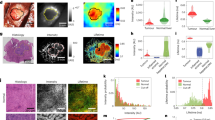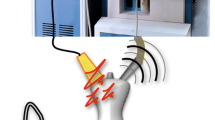Abstract
The effects of different parameters of interest for the localization of malignant tumours in situ by means of laser-induced fluorescence and haematoporphyrin derivatives were investigated. Such parameters are drug composition, drug concentration, laser pulse energy and excitation wavelength. In order to assess the relative merits of the two tumor-seeking agents Photofrin (haematoporphyrin derivative) and Photofrin II (dihaematoporphyrin ether) we have performed a comparative study on rat tissues. The results suggest that Photofrin is at least as good as the therapeutically more potent agent Photofrin II. A linear relation between drug dose and recorded porphyrin fluorescence intensity was also found. Using not only the porphyrin fluorescence, but also natural tissue autofluorescence, better tumour demarcation is observed when utilizing an excitation wavelength shorter than the porphyrin excitation peak at 405 nm.
Similar content being viewed by others
References
Dougherty TJ, Kaufman JE, Goldfarb A et al. Photoradiation therapy and treatment of malignant tumors.Cancer Res 1978,38:2628–35
Dougherty TJ, Potter WR, Weishaupt KR. The structure of the active component of hematoporphyrin derivative. In: Andreoni A & Cubeddu R (eds),Porphyrins in tumor phototherapy. New York: Plenum Press, 1984:23–35
Kessel D. In vivo flurescence of tumors after treatment with derivatives of hematoporphyrin.Photochem Photobiol 1986,44:107–8
Moan J, Sommer S. Fluorescence and absorption properties of the components of haematoporphyrin derivative.Photobiochem Photobiophys 1981,3:93–103
Bonnet R, Berenbaum MC, Kaur H. Chemical and biological studies on haematoporphyrin derivative: an unexpected photosensitisation in brain. In: Andreoni A & Cubeddu R (eds)Porphyrins in tumour phototherapy. New York: Plenum, 1984;67–80
Sun C-H, Duzman E, Mellott J, Liaw L-H, Berns MW. Spectroscopic, morphologic, and cytotoxic studies on major fractions of hematoporphyrin derivative and Photofrin II.Lasers Surg Med 1987,7:171–9.
Cadby PA, Dimitriadis E, Grant HG et al. The analysis of hematoporphyrin derivative. In: Kessel D & Dougherty TJ (eds)Porphyrin photosensitization. New York, London: Plenum, 1983:251–63
Cubeddu R, Keir WF, Ramponi R, Truscott TG. Photophysical properties of porphyrin-chlorin systems in the presence of surfactants.Photochem Photobiol 1987,46 (in press)
Andreoni A, Cubeddu R. (eds),Porphyrins in tumor phototherapy, New York: Plenum, 1984
Hayata Y (ed) Proceedings of the First International Conference on the Clinical Application of Photosensitization for Diagnosis and Treatment, April 1986, Tokyo (in press)
Kinsey JH, Cortese DA. Endoscopic system for simultaneous visual examination and electronic detection of fluorescence.Rev Sci Instr 1980,51:1403–6
Profio AE, Doiron DR, Balchum OJ, Huth GC. Fluorescence bronchoscopy for localization of carcinoma in situ.Med Phys 1983,10:35–9
Kato H, Aizawa K, Ono J et al. Clinical measurement of tumor fluorescence using a new diagnostic system with hematoporphyrin derivative, laser photoradiation, and a spectroscope.Lasers Surg Med 1984,4:49–58
Ankerst J, Montán S, Svanberg K, Svanberg S. Laser-induced fluorescence studies of hematoporphyrin derivative (HPD) in normal and tumor tissue of rat.Appl Spectr 1984,38:890–6
Svanberg K, Kjellén E, Ankerst J et al. Fluorescence studies of hematoporphyrin derivative in normal and malignant rat tissue.Cancer Res 1986,46:3803–8
Profio AE, Doiron DR, Sarnaik J. Fluorometer for endoscopic diagnosis of tumors.Med Phys 1984,11:516–20
Pottier R, Laplante JP, Chow Y-F A, Kennedy J. Photofrins: a spectral study.Can J Chem 1985,63:1463–7
Andreoni A, Cubeddu R. Fluorescence properties of HPD and its components. In: Andreoni A & Cubeddu R (eds)Porphyrins in tumor phototherapy. New York: Plenum, 1984:11–12
Kessel D. Components of hematoporphyrin derivatives and their tumor-localization capacity.Cancer Res 1982,42:1703–6
Kessel D, Chou TH. Tumor-localizing components of the porphyrin preparation hematoporphyrin derivative.Cancer Res 1983,43:1994–9
Doiron DR, Profio AE, Vincent RG, Dougherty TJ. Fluorescence bronchoscopy for detection of lung cancer.Chest 1979,76:27–32
Mang TS, Dougherty TJ, Potter WR et al. Photobleaching of porphyrins used in photodynamic therapy and implications for therapy.Photochem Photobiol 1987,45:501–6
Schneckenburger H, Unsöld E, Weinsheimer W, Jocham D. Time-resolved laser fluorescence and photobleaching of single cells after photosensitization with hematoporphyrin derivative (HPD). In: Andreoni A & Cubeddu R (eds)Porphyrins in tumor phototherapy. New York: Plenum, 1984:137–41
Fingar VH, Potter WR, Henderson BW. Drug and light dose dependence of photodynamic therapy: a study of tumor cell clonogenicity and histologic changes.Photochem Photobiol 1987,45:643–50
Hedlund G, Sjögren HO. Induction of transplantation immunity to rat colon carcinoma isografts by implantation of intact fetal colon tissue.Int J Cancer 1980,26:71–3
Yamashita M, Nomura M, Kobayashi S et al. Picosecond time-resolved fluorescence spectroscopy of hematoporphyrin derivative.IEEE J Quant Electron 1984.QE-20: 1363–9
Montán S, Svanberg K, Svanberg S. Multicolor imaging and contrast enhancement in cancer-tumor localization using laser-induced fluorescence in hematoporphyrin-derivative-bearing tissue.Opt Lett 1985,10:56–8
Andersson PS, Montán S, Svanberg S. Multispectral system for medical fluorescence imaging.IEEE J Quant Electron 1987,QE-23:1798–805
Andersson-Engels S, Brun A, Kjellén E et al. Detection of brain tumors in rats using laser-induced fluorescence and hematoporphyrin derivative, 1987, submitted toJ Neurosurg
Author information
Authors and Affiliations
Rights and permissions
About this article
Cite this article
Andersson-Engels, S., Ankerst, J., Montan, S. et al. Aspects of tumour demarcation in rats by means of laser-induced fluorescence and haematoporphyrin derivatives. Laser Med Sci 3, 239–248 (1988). https://doi.org/10.1007/BF02593819
Received:
Issue Date:
DOI: https://doi.org/10.1007/BF02593819




